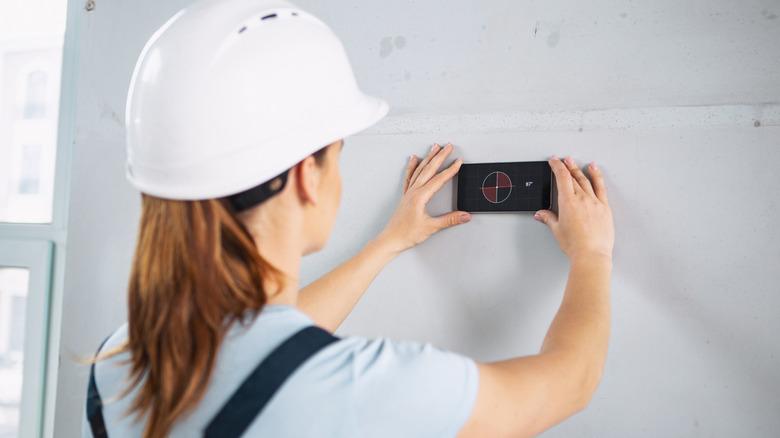Are Stud Finder Apps Reliable? Here's How They Work And If They're Worth Using
Stud finders are among those tools you need to properly hang wall art, mirrors, or any item too heavy to use just anchors or nails directly into drywall. Simpler stud finders use magnets to identify where nails or screws are in the studs behind the drywall so that you can have sturdier support for your heavy objects. But before you run to the hardware store to pick up a stud finder, open your phone's map software and see if it can point to north. If so, then your phone has a magnetometer inside it and you can use your phone as a stud finder that's just as reliable as a magnetic standalone stud finder.
You use your phone app just like you would use a standalone stud finder. After you've opened the app, you just slide your phone against the wall until the app signals the presence of a metal object. Metal studs are obviously easier to find than individual nails, but that's no different from what a magnetic standalone stud finder can do. This means that stud finder apps are no more but no less reliable than magnetic standalone stud finders.
The real reliability issue is that magnets are just metal finders, not stud finders. The metal detected behind the wall may be a nail in a stud, but it may also be metal piping, an electrical junction box, or something else. If a nail is driven in incorrectly, at an angle, or off-center, you may not get a correct sense of where the stud is. There may be diagonal or irregularly added studs or other metal objects behind the drywall, which can be confusing if you are anticipating vertical and horizontal studs.
Some standalone stud finders are better than phone apps
Like any other app, some stud finder apps are free, some have in-app purchases, and some require subscriptions that come with additional features. For simple jobs, there's really no reason to purchase a standalone magnetic stud finder. But some standalone magnetic stud finders come with features that phone apps don't have. One budget model comes with assorted hooks and nails, for what that's worth. Another might come with laser beams to better help you mark the wall. While lower-cost stud finders are able to detect studs in drywall up to ¾ inch deep, more expensive "deep scan" models with stronger or more magnets can identify studs twice as deep or more.
If you want a more reliable stud finder, however, look for a standalone stud finder that has electronic detectors. By detecting changes in electrical currents to measure the density of the materials behind the wall, electronic stud finders can find actual studs, not just metal objects. They use these signals to identify the center and edges of studs, not just the nail in the stud. And because they are detecting electrical currents, some models will identify live wiring, which can prevent you from accidentally hitting wires with electricity running through them.
In the end, what's the best type of stud finder?
Ask a contractor or hardware store employee what's the best way to find studs, and you might get an old-school answer questioning the effectiveness of stud finders (whether standalone or phone apps). They might assert that they're not always accurate. Contractors might simply rely on the no-cost technique of finding a stud without a stud finder by tapping lightly on the drywall and listening for a solid thud, rather than a more hollow sound. Some just tap a thin finishing nail into the spot and see if it hits a stud. They might scoff at the $60 or more you can spend on a "professional" stud finder with 13 or more sensors and 21 LED displays that professionals may not actually use, only to find that it works no better than a simple magnet.
Then again, merely tapping on the wall may not be any better at finding irregular studs. Trial and error may be the only way for you to find out which is the best type of stud finder. If you already have a standalone stud finder, a phone app isn't likely to make your job easier. If you don't have one and you don't want to go around tapping on your walls or spending a lot of money, try a phone app. For greater certainty, however, spend the extra money on an electronic stud finder.


